QuantVPS delivers ultra-low latency AMD Ryzen servers in Chicago, tailored for traders who need fast, precise execution. With a 0.52 ms latency to CME, direct fiber connections, and 100% dedicated resources, it’s designed for high-frequency trading platforms like NinjaTrader and MetaTrader. While competitors like OVHCloud, Hetzner, and Vultr offer Ryzen servers at lower prices, they lack trading-specific features, direct exchange connectivity, and comparable latency performance. QuantVPS also guarantees 99.999% uptime and 24/7 expert support, making it a top choice for professionals. Pricing starts at $249.99/month.
Quick Comparison
| Provider | Latency to CME | Trading Optimizations | Uptime SLA | Support Focus | Pricing (Starting) |
|---|---|---|---|---|---|
| QuantVPS | 0.52 ms | Yes | 99.999% | Trading-specific | $249.99/month |
| OVHCloud | 8–15 ms | No | 99.9% | General hosting | $60/month |
| Hetzner | 40–80 ms | No | 99.9% | General hosting | $36/month |
| Vultr | 5–20 ms | No | 99.99% | General hosting | $120/month |
| Liquid Web | 10–20 ms | No | 99.999% | General hosting | $150/month |
For latency-critical trading, QuantVPS offers unmatched speed and reliability, justifying its premium pricing.
1. QuantVPS
QuantVPS stands out by focusing on what matters most to traders: speed and reliability. Designed specifically for latency-sensitive trading, it delivers ultra-fast execution times.
Latency to CME
At the heart of QuantVPS’s service is its direct connection to major trading venues. Located in Chicago, their data center achieves an impressive 0.52 ms latency to CME Group, thanks to direct fiber cross-connects. This kind of low latency offers traders a critical advantage when every millisecond counts. Additionally, QuantVPS ensures seamless and consistent low-latency order routing through direct links to Rithmic networks.
Trading-Specific Optimizations
QuantVPS is pre-configured to support popular trading platforms like NinjaTrader, Quantower, MetaTrader, and Bookmap, allowing traders to deploy strategies instantly without additional setup. Each server provides 100% dedicated AMD Ryzen CPU resources, ensuring that trading applications perform at their best.
Hardware Flexibility
For traders with varying needs, QuantVPS provides customizable hardware options. Their AMD Ryzen processors, such as the 7950X3D, 9900X, and 9950X, are equipped with 3D V-Cache technology, making them ideal for handling tick data. Memory configurations can go up to 256 GB DDR5, making them suitable for even the most data-heavy algorithms. Storage is equally robust, with NVMe SSDs up to 8 TB, ensuring smooth backtesting and data storage. For those using advanced visualization tools or AI-powered strategies, NVIDIA RTX GPUs are available on select builds through the sales team.
Support and Uptime Guarantees
In trading, reliability is everything. QuantVPS offers a 99.999% uptime SLA, supported by redundant power systems, network connections, and hardware components in its Chicago facility. Traders also benefit from 24/7 expert support, ensuring minimal disruptions. Additional safeguards like automatic backups, proactive monitoring, and DDoS protection further enhance system security and reliability.
These features combine to make QuantVPS a powerful choice for traders, as we’ll explore further in the next sections.
2. OVHCloud
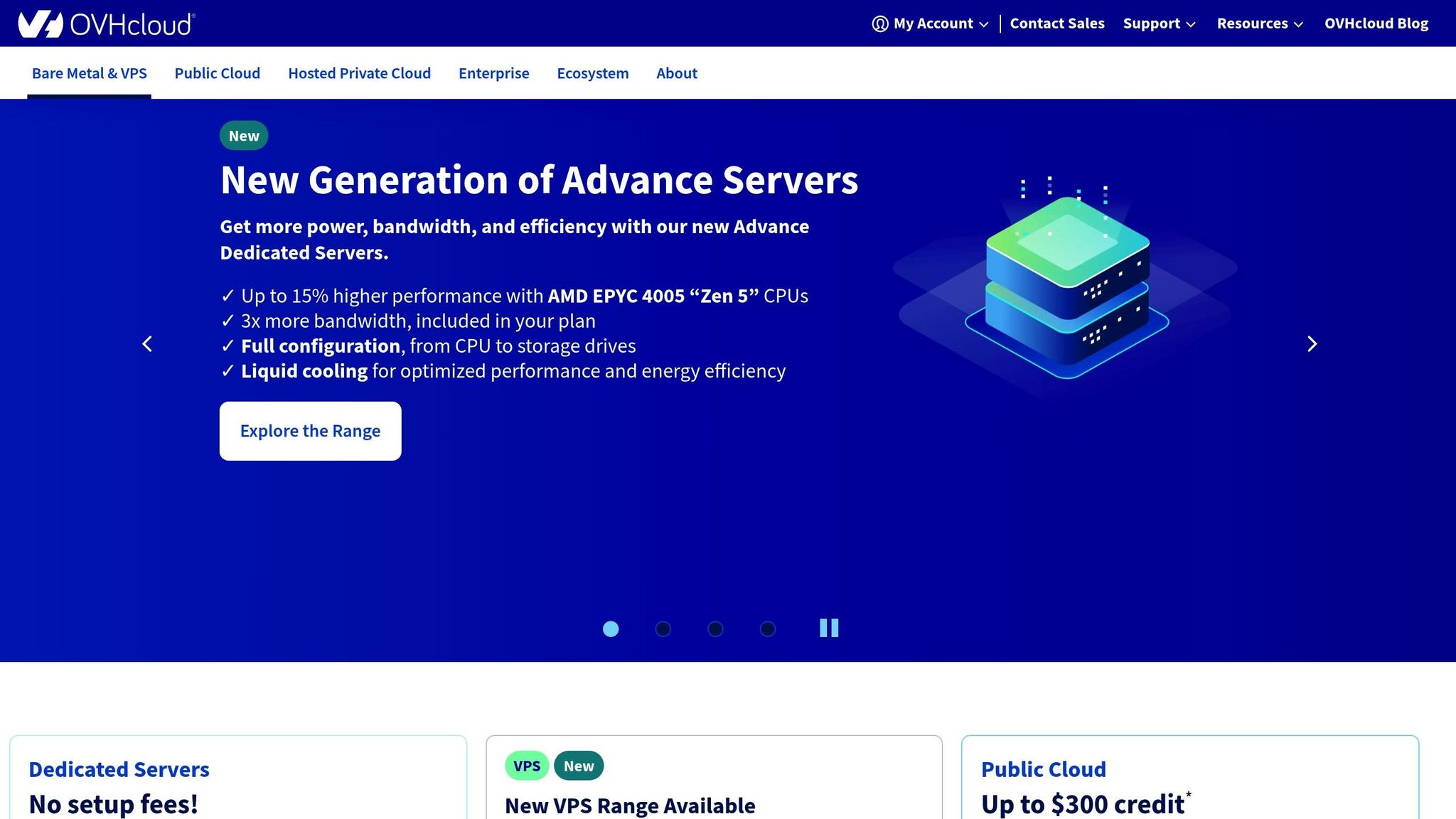
OVHCloud is one of the largest hosting providers globally. While they do offer AMD Ryzen dedicated servers, their services cater to a broader audience and aren’t specifically designed for traders needing fast access to the Chicago Mercantile Exchange (CME).
Latency to CME
One of the main challenges for traders using OVHCloud is latency. The company doesn’t operate a data center with direct connectivity to the CME in Chicago. Instead, their North American servers are located in Vint Hill, Virginia, and Beauharnois, Canada. This physical distance results in a noticeable latency penalty, typically ranging from 8–15 milliseconds or more when connecting to CME. For trading environments where every millisecond counts, this can be a significant drawback.
Trading-Specific Optimizations
OVHCloud’s offerings lack the trading-specific features found in specialized providers. They don’t provide pre-configured operating system images for platforms like NinjaTrader, Quantower, or MetaTrader. Similarly, they don’t offer direct exchange routing or low-latency network paths tailored for trading workloads. This means traders must handle all the technical configurations themselves, from optimizing Windows Server for latency reduction to setting up efficient network routing.
Hardware Flexibility
OVHCloud offers a variety of AMD Ryzen dedicated servers, including Ryzen 5, Ryzen 7, and Ryzen 9 models, with Ryzen 9 configurations starting at around $120–$180 per month. However, their hardware customization options are somewhat limited compared to trading-focused providers. Features like DDR5 RAM, high-frequency Ryzen CPUs, or GPU add-ons for AI or machine learning trading workloads may not be readily available. This lack of tailored hardware options highlights their more general-purpose approach rather than one focused on high-performance trading needs.
Support and Uptime Guarantees
OVHCloud provides a standard 99.9% uptime SLA for their dedicated servers, which ensures a reasonable level of reliability. However, this SLA allows for up to 43 minutes of potential downtime per month, which could be problematic for traders running live strategies. Their support system operates through ticket-based channels and doesn’t offer the specialized expertise or rapid response times that high-frequency trading environments often require. Additionally, while OVHCloud includes basic DDoS protection, it lacks the advanced network security features tailored to the needs of traders requiring optimized exchange connectivity.
3. Hetzner
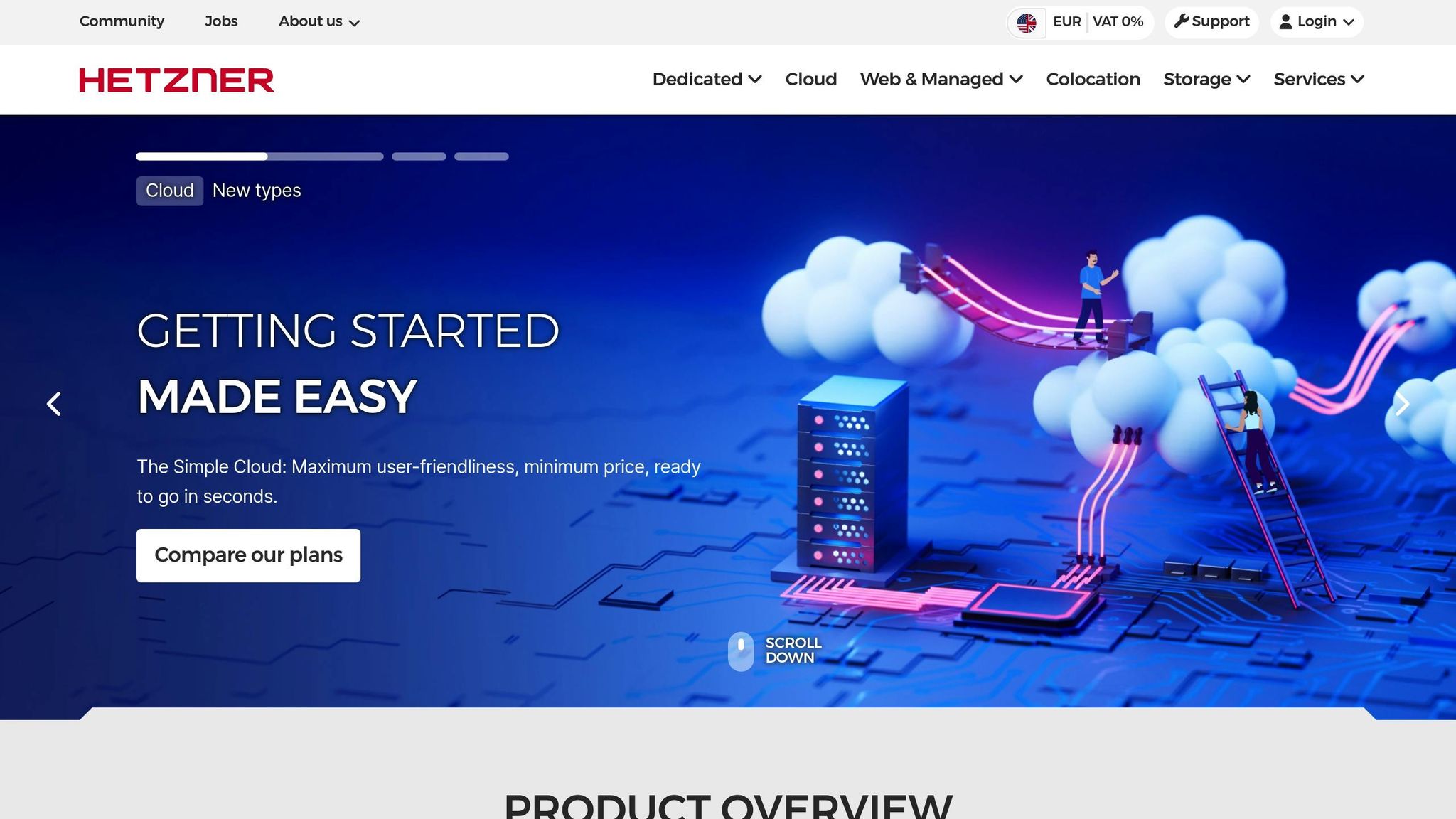
Hetzner, a German hosting provider known for its AMD Ryzen dedicated servers, presents a challenge for U.S.-based traders due to its European data center locations. For those in trading, where every millisecond counts, this geographic limitation can be a major hurdle.
Latency to CME
For traders connecting to U.S. exchanges, Hetzner’s latency is a significant issue. With data centers situated in Germany and Finland, servers experience latencies ranging from 70 to 120 milliseconds when connecting to the Chicago Mercantile Exchange (CME). By comparison, servers hosted in Chicago boast latencies of less than 1 millisecond, giving them a clear edge. This stark difference highlights the performance gap between general-purpose hosting solutions and servers tailored for trading.
Lack of Trading-Specific Features
Hetzner’s servers are built for general workloads and lack the fine-tuning required for trading platforms like NinjaTrader, Quantower, or MetaTrader. They do not offer direct exchange routing or specialized peering agreements, which leads to additional network hops and higher latency – both of which are undesirable for trading.
Hardware Limitations
Although Hetzner provides customizable AMD Ryzen configurations, the hardware options are not geared toward low-latency trading. Features like high-frequency CPUs, DDR5 memory, or GPUs – key components for trading applications – are notably absent.
Support and Reliability
Hetzner guarantees a standard 99.9% uptime SLA and offers 24/7 support. However, the support team lacks expertise in trading-specific requirements, and DDoS protection is only available as a paid add-on, which might not meet the expectations of traders who need robust and specialized assistance.
4. Ionos by 1&1
Ionos by 1&1 is one of the largest hosting providers in Europe, offering AMD Ryzen dedicated servers with a focus on enterprise clients. However, for U.S.-based traders who rely on ultra-low latency connections to major exchanges, this provider has some limitations that may not align with the demands of professional trading environments.
Latency to CME
One key drawback is the lack of data centers in Chicago and the absence of direct exchange peering, which leads to latency of several milliseconds when connecting to the CME. For futures traders and professionals working with proprietary trading firms, this added latency can result in slower order execution – an issue that’s hard to overlook in latency-critical scenarios.
Trading-Specific Optimizations
Ionos by 1&1 sticks to standard enterprise configurations, which lack the pre-tuned optimizations needed for trading platforms like NinjaTrader and MetaTrader. This means traders must manually handle adjustments to minimize latency. Features like kernel tuning or network tweaks, which are often essential for professional trading setups, are not included out of the box.
Hardware Flexibility
While AMD Ryzen servers are available, the options for customizing high-performance, low-latency setups are somewhat restricted. Advanced features like high-speed DDR5 memory or specialized GPUs aren’t readily offered and often require contacting sales for a custom quote. This process might not align with the fast deployment timelines that traders in latency-sensitive environments often require.
Support and Uptime Guarantees
Ionos provides standard enterprise support paired with a 99.9% uptime SLA. However, the support team lacks expertise in trading-specific issues, which could lead to delays in resolving latency-related problems. Additionally, there’s a noticeable absence of case studies or testimonials from professional traders who use Ionos for latency-sensitive trading, raising questions about its suitability for serious trading operations.
5. Vultr Bare Metal
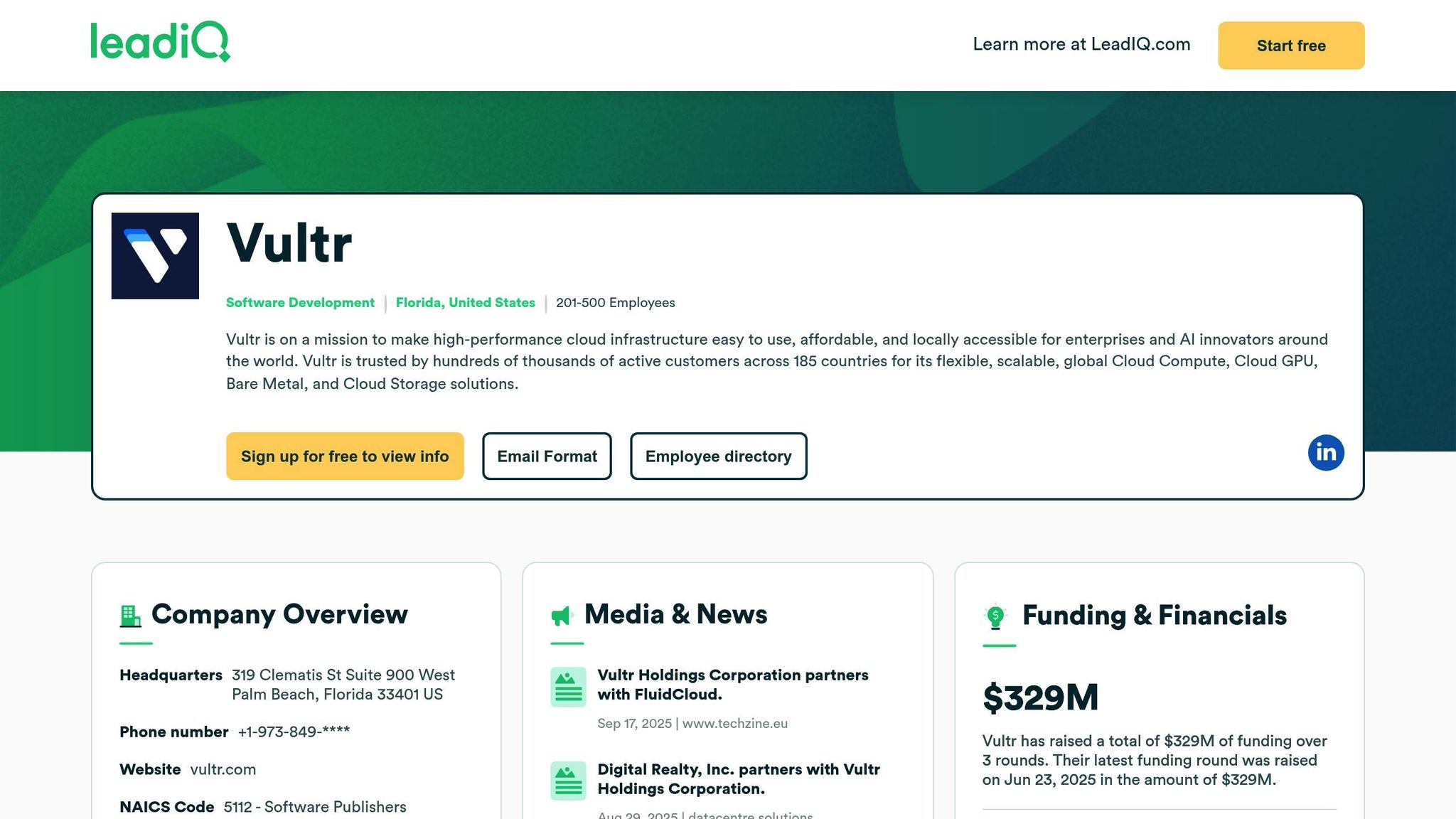
Vultr Bare Metal offers AMD Ryzen dedicated servers, but it falls short in addressing the specific needs of ultra-low latency trading environments.
Latency to CME
Vultr doesn’t provide direct connections to exchanges. Without being located in CME-adjacent data centers or having direct peering, it experiences latencies ranging from 5 to 20 ms. This is a stark contrast to the sub-1 ms latency provided by trading-optimized hosts, highlighting the importance of specialized setups for traders.
Trading‑Specific Optimizations
Out of the box, Vultr’s configurations lack the fine-tuning needed for trading. There are no pre-configured operating system images or optimized exchange routing. Traders are left to handle these adjustments on their own, which could lead to inefficiencies or delays in executing algorithmic strategies.
Hardware Flexibility
While Vultr does offer Ryzen processors and some GPU options, these are not designed to meet the demands of trading visualization or AI-driven workloads. This lack of tailored hardware can be a significant drawback for traders who rely on advanced tools and real-time analytics.
Support and Uptime Guarantees
In trading, time is money – literally. Although Vultr provides 24/7 support and a 99.99% uptime SLA, their services are not focused on the unique challenges of trading environments. This can lead to slower response times and less specialized assistance when troubleshooting latency or other trading-specific issues.
6. Linode / Akamai Cloud
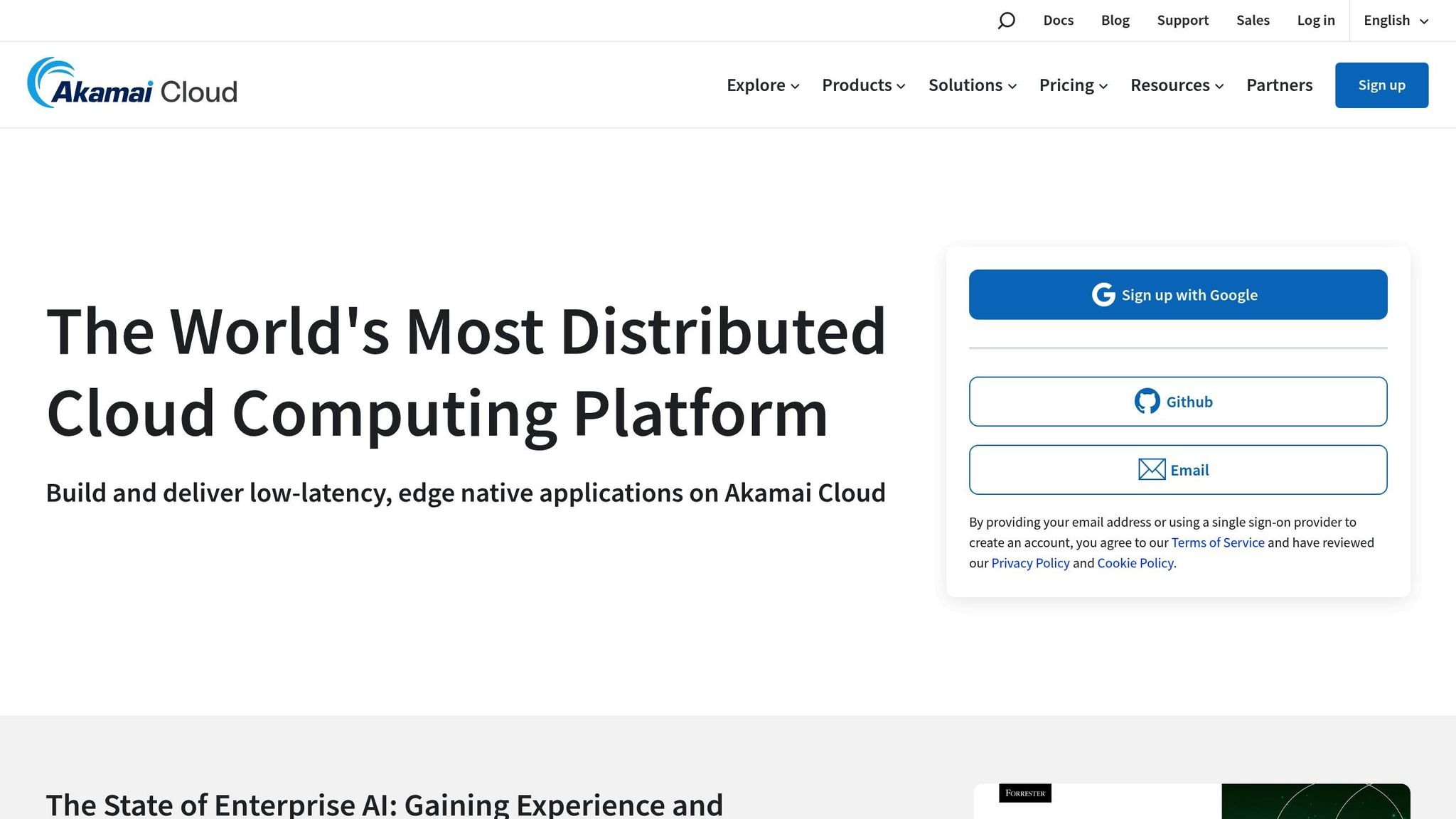
Linode, now operating under the Akamai Cloud brand after its 2022 acquisition, has long been a trusted name in cloud hosting, particularly for developers and enterprise workloads. But when it comes to the ultra-precise demands of latency-sensitive trading environments, this general-purpose platform struggles to meet the mark. High-frequency trading requires solutions designed specifically for millisecond-level precision, and Akamai Cloud isn’t built for that level of performance.
One major limitation is its lack of direct fiber cross-connects to key Chicago exchanges like CME and Rithmic networks. Without these connections, latency can range from 10 to 30 milliseconds, which is a far cry from the sub-1 millisecond speeds that trading-focused solutions can achieve. For futures traders and professionals in proprietary trading firms, even these seemingly small delays can mean missed trades and lost opportunities in the fast-paced world of high-frequency trading.
Another drawback is the absence of trading-specific optimizations. Akamai Cloud doesn’t offer pre-configured operating systems for popular trading platforms like NinjaTrader, Quantower, or MetaTrader. Traders are left to handle all performance tuning on their own, from tweaking operating systems to configuring exchange routing. This makes the platform better suited for general developer needs rather than the specialized requirements of algorithmic or high-frequency trading.
Hardware limitations further highlight the platform’s general-purpose nature. Akamai Cloud relies on Intel Xeon and AMD EPYC processors, which are solid choices for many workloads but fall short for trading applications. It doesn’t offer the latest AMD Ryzen processors with 3D V-Cache or custom configurations like high-frequency Ryzen CPUs, DDR5 memory, or large NVMe storage arrays – components that are essential for handling the tick-level performance traders rely on.
While Akamai Cloud does provide a 99.99% uptime SLA and round-the-clock support, its support team is geared toward general cloud issues. They aren’t equipped to handle trading-specific problems like exchange connectivity or latency troubleshooting. During critical market moments, this lack of specialized support could lead to frustrating delays for traders who need immediate assistance.
7. Liquid Web
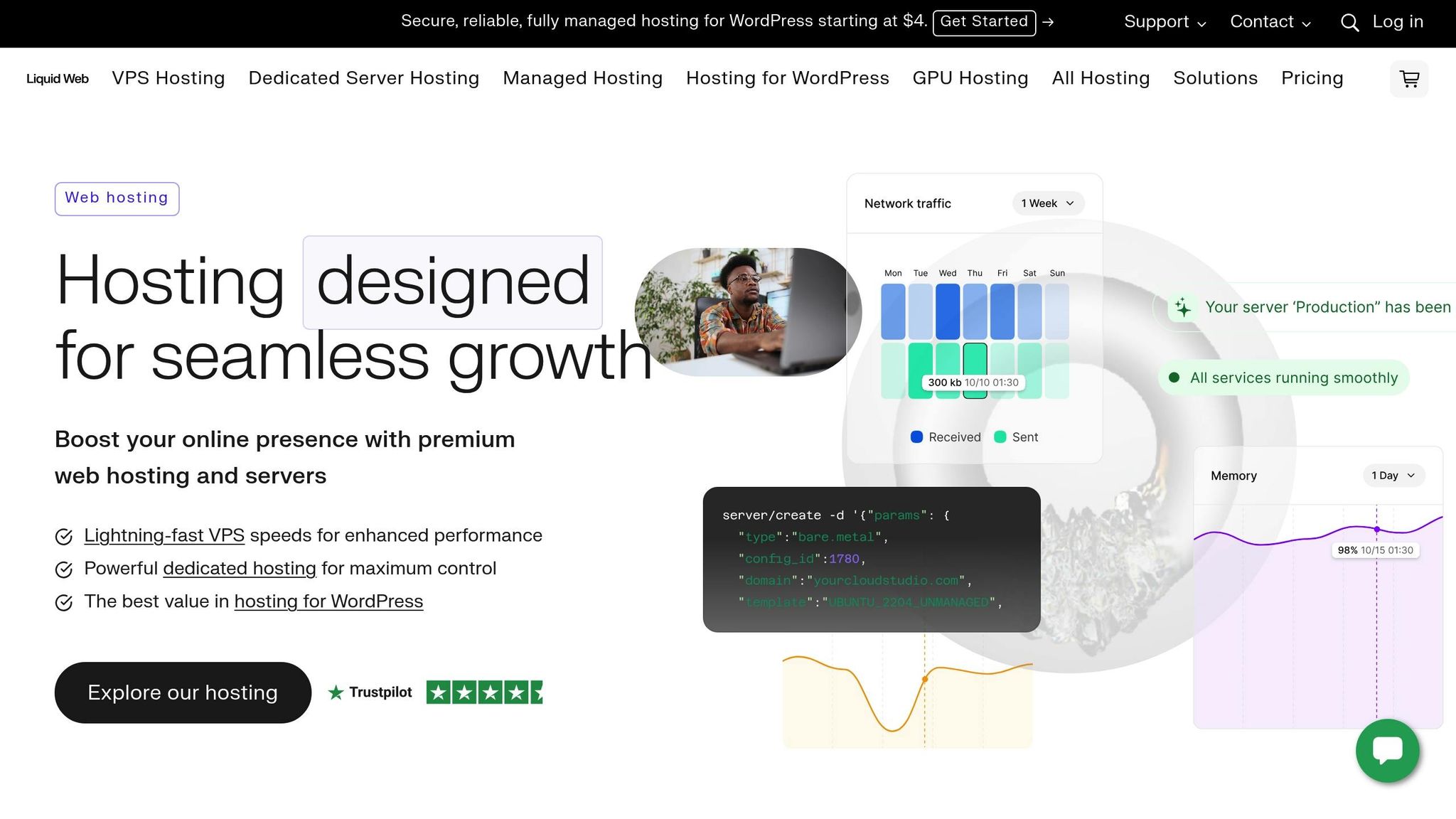
Liquid Web is often praised for its reliability in managed hosting, but when it comes to trading applications – especially high-frequency trading – it falls short in several key areas.
Latency to CME
One of the biggest drawbacks for traders is Liquid Web’s lack of direct connectivity to Chicago’s financial exchanges, such as the CME. Without direct fiber cross-connects to CME or Rithmic, latency becomes a serious issue. Providers designed for low-latency trading can achieve sub-1 millisecond latency through direct peering, but Liquid Web relies on routing that involves multiple network hops. This results in latency levels that are far from ideal for high-frequency trading.
Trading-Specific Optimizations
Liquid Web operates as a general-purpose hosting provider, which means it doesn’t offer optimizations tailored to trading. There are no pre-configured operating systems for popular platforms like NinjaTrader, Quantower, or MetaTrader. Traders are left to handle the configuration of operating systems and exchange routing on their own, adding complexity and time to the setup process.
Hardware Flexibility
While Liquid Web does allow some customization for its dedicated servers, its hardware options are not geared toward the specific needs of trading workloads. For example, it doesn’t consistently offer AMD Ryzen CPUs with 3D V-Cache, high-frequency DDR5 memory, or on-demand GPU builds – components that are crucial for advanced trading setups. Traders looking for processors like the Ryzen 7950X3D, DDR5 memory configurations up to 256 GB, or NVIDIA RTX GPUs for AI-driven trading applications may find Liquid Web’s offerings insufficient.
Support and Uptime Guarantees
Liquid Web boasts a 99.999% uptime SLA and provides 24/7/365 support, which is excellent for general hosting needs. However, its support team lacks the specialized knowledge required to address trading-specific issues. Challenges like exchange connectivity problems, latency spikes, or platform optimizations may not be resolved quickly enough during critical market moments. While the uptime reliability is solid, the absence of trading-focused support makes Liquid Web less suitable for high-frequency trading environments.
Next, we’ll take a closer look at how support and uptime affect trading performance.
8. InterServer
InterServer provides AMD Ryzen dedicated servers at competitive prices, but it doesn’t quite meet the stringent requirements of trading environments. While the company offers customizable hardware options, its services are more suited to general workloads rather than being tailored for trading-specific needs.
Latency to CME
When it comes to network performance, InterServer’s limitations become apparent. The absence of direct fiber cross-connects to the CME means that data must pass through multiple network hops before reaching the exchange. This results in latency of a few milliseconds – far above the sub-1 millisecond performance that high-frequency traders demand.
This higher latency can negatively impact order execution speed, a critical factor for futures and proprietary traders where every microsecond counts. Without trading-focused network optimizations, InterServer’s architecture places it at a disadvantage compared to providers specifically designed for low-latency trading.
Trading-Specific Optimizations
InterServer does not include pre-configured operating systems or optimizations for popular trading platforms like NinjaTrader, MetaTrader, Quantower, or Bookmap. This means traders may need to invest extra time and effort to configure their systems during crucial trading hours, which could be a drawback for those seeking a plug-and-play solution.
Hardware Flexibility
Although InterServer offers a variety of AMD Ryzen-based dedicated servers, its customization options are somewhat limited for advanced trading needs. Standard configurations often lack cutting-edge features like DDR5 memory, 3D V-Cache CPUs, or GPU-equipped setups. Traders requiring highly specialized hardware configurations may need to submit special requests, which could delay deployment.
Support and Uptime Guarantees
InterServer provides 24/7 technical support and a standard 99.9% uptime SLA. However, its support team is geared toward general hosting issues rather than the specific demands of trading environments. They may lack expertise in areas like trading platform support, exchange connectivity, or latency optimization. This could be a challenge for traders who rely on expert assistance to maintain seamless operations.
The table below highlights how InterServer compares to trading-focused providers:
| Feature | InterServer | Trading-Focused Providers |
|---|---|---|
| CME Latency | A few milliseconds | <1 millisecond with direct peering |
| Trading Optimizations | None | Pre-tuned OS and platforms |
| Uptime SLA | 99.9% | 99.999% |
| Support Focus | General hosting | Trading-specific expertise |
InterServer might appeal to budget-conscious traders who don’t require ultra-low latency and are comfortable handling system optimizations on their own. However, for professional trading operations or latency-critical applications, the lack of exchange-specific infrastructure and trading-focused expertise makes it less suitable.
9. PhoenixNAP

PhoenixNAP stands out as a global hosting provider, offering AMD Ryzen dedicated servers with customizable configurations. However, its infrastructure has some notable limitations, especially for high-frequency trading (HFT) where speed and precision are critical. For instance, its Chicago servers experience higher latency due to the absence of direct fiber cross-connects.
Latency to CME
One of the biggest challenges with PhoenixNAP is its latency. With multiple network hops required, the latency to the CME averages between 2–5 milliseconds. This falls short of the sub-1 millisecond latency that high-frequency traders rely on to avoid missed trades and maintain competitive positioning.
Trading-Specific Optimizations
PhoenixNAP’s servers come with standard Windows Server configurations, but they lack any trading-specific optimizations. Without direct peering to exchanges like CME, Rithmic, or CQG, traders must depend on public internet routing. This not only increases latency but also introduces potential reliability concerns, making it less suitable for demanding trading environments.
Hardware Flexibility
The hardware options at PhoenixNAP are robust, offering AMD Ryzen servers with up to 2 TB of RAM, NVMe drives, and GPU accelerators. However, these features are not fine-tuned for trading. For instance, they don’t include specialized components like 3D V-Cache CPUs or DDR5 tuning, which are crucial for processing tick data efficiently. While the hardware is flexible, it doesn’t compensate for the lack of trading-focused configurations.
Support and Uptime Guarantees
PhoenixNAP provides 24/7 technical support and guarantees 100% network and power uptime. However, their support team lacks the expertise to address trading-specific issues, such as troubleshooting order execution delays or platform connectivity problems. This can be a significant drawback for traders who need quick and specialized assistance.
| Feature | PhoenixNAP | Trading-Focused Providers |
|---|---|---|
| CME Latency | 2–5 milliseconds | <1 millisecond |
| Hardware Flexibility | Very high (up to 2 TB RAM) | High (trading-optimized) |
| Trading Optimizations | None | Pre-tuned OS and platforms |
| Support Expertise | General hosting support | Trading-specific support |
| Uptime SLA | 100% network/power | 99.999% comprehensive |
Pricing for PhoenixNAP starts at $120–$150 per month for entry-level configurations, with high-end Ryzen servers ranging from $250 to $600 per month based on specifications. While the pricing is competitive for general-purpose workloads, it doesn’t include the specialized features and optimizations that professional trading operations require.
10. OVH US (Beauharnois / Vint Hill)
OVH US operates data centers in Beauharnois and Vint Hill, but their geographic distance from Chicago results in latencies of 15–20 ms (Beauharnois) and 10–15 ms (Vint Hill). These figures are significantly higher than the sub-1 ms latency offered by Chicago-based trading servers, making OVH US less suitable for latency-sensitive trading operations.
Latency to CME
The latency to the CME exchange is a key drawback for OVH US. Unlike Chicago-based hosts that achieve sub-1 ms latency thanks to their proximity and direct fiber connections, OVH US relies on public internet routing. This introduces additional network hops, increasing delays and potentially affecting reliability. For traders, this can mean slower order execution and less consistent performance during critical market periods.
Trading-Specific Optimizations
OVH US does not offer pre-configured environments tailored for trading. Users must manually set up their trading platforms, which can be time-consuming and may not achieve the same level of performance as pre-optimized solutions. Additionally, there are no direct connections to trading networks like CME, Rithmic, or CQG. Instead, trading data travels through standard internet routes, which can lead to unpredictable latency, especially during high-traffic market hours.
Hardware Flexibility
While OVH US provides a variety of AMD Ryzen and EPYC configurations with generous RAM and NVMe storage, these setups lack the fine-tuning needed for trading workloads. Features like 3D V-Cache or DDR5 tuning, which are crucial for high-frequency trading, are absent. Networking options are also standard, without the specialized configurations that trading-focused providers offer.
Support and Uptime Guarantees
OVH US offers 24/7 ticket-based support and a 99.99% uptime SLA. However, their support team lacks the trading-specific expertise required to resolve latency or connectivity issues that impact order execution. During peak trading hours, this could lead to delays in addressing critical problems, which is a major concern for traders.
The table below highlights how OVH US compares to trading-optimized providers:
| Feature | OVH US (Beauharnois / Vint Hill) | Trading-Focused Providers |
|---|---|---|
| CME Latency | 10–20 milliseconds | <1 millisecond |
| Hardware Options | General-purpose | Trading-optimized |
| Exchange Connectivity | Public internet routing | Direct fiber peering |
| Support Expertise | General hosting | Trading-specialized |
| Uptime SLA | 99.99% | 99.999% |
Pricing Overview
OVH US offers competitive pricing, starting at $100–$150 per month for entry-level models and reaching $200–$400 for higher-end configurations. However, these lower costs do not offset the lack of trading-specific features and optimizations, which are critical for achieving low latency and reliable performance in trading environments.
Pros and Cons Comparison
Below is a breakdown of the advantages and drawbacks of various hosting providers, focusing on their suitability for trading-optimized infrastructure.
| Provider | Pros | Cons |
|---|---|---|
| QuantVPS | Ultra-low latency (0.52 ms to CME) with direct fiber cross-connects, trading-optimized Ryzen 7950X3D/9900X/9950X with DDR5 up to 256 GB, 99.999% uptime SLA, and 24/7 trader support with response times under 4 minutes | Limited to Chicago and New York locations; higher pricing ($249.99–$399.99/month); no hourly billing options |
| OVHCloud | Global datacenter presence, competitive pricing starting around $60/month, solid Ryzen hardware configurations | Lacks trading optimizations, exhibits 10–20+ ms latency, and offers generic support with 99.9% uptime |
| Hetzner | Extremely competitive pricing (€34.51/~$36 entry level), robust hardware specifications, reliable European infrastructure | Europe-based locations result in 40–80 ms latency to U.S. exchanges; not optimized for trading platforms |
| Ionos by 1&1 | Enterprise-grade reliability, strong business hosting reputation, decent hardware options | Minimal trading customization; 20–40 ms latency to exchanges; limited algorithmic setup flexibility |
| Vultr Bare Metal | True bare metal performance, good hardware specs, multiple U.S. locations, competitive pricing ($120–$320+/month) | No exchange routing control; lacks trading-specific tuning; 5–15 ms latency without optimization |
| Linode/Akamai Cloud | Developer-friendly platform, flexible configurations, strong cloud infrastructure | Not suitable for latency-critical trading; 10–20 ms latency; developer-focused rather than trading-optimized |
| Liquid Web | Managed hosting expertise, reliable infrastructure, good uptime (99.99% SLA) | Not trading-focused; 10–20 ms latency to exchanges; higher pricing without trading benefits |
| InterServer | Affordable Ryzen server options, straightforward pricing, decent hardware configurations | Generic hosting model; no direct market connectivity; 10–20 ms latency; lacks trading platform optimization |
| PhoenixNAP | Solid hardware specifications, U.S.-based locations, reliable infrastructure | Slower Chicago latency routes compared to trading hosts; not trading-optimized; 10–20 ms latency |
| OVH US | Popular in North America, affordable pricing ($100–$400/month), decent hardware options | 15–20× slower CME routes than QuantVPS (8–15 ms vs. 0.52 ms); no trading-specific features; generic support |
This comparison highlights a clear divide between general hosting providers and those tailored for trading. While many providers offer competitive pricing, they often lack the specialized features needed for latency-critical trading. For instance, QuantVPS stands out with its ultra-low latency of 0.52 ms to CME and trading-optimized hardware, making it a top choice for high-frequency traders. In contrast, competitors like Hetzner or OVHCloud may offer lower costs but cannot match the speed and precision required for algorithmic trading.
The premium pricing of QuantVPS, ranging from $249.99 to $399.99 per month, reflects its focus on performance and reliability. While providers like Hetzner are significantly cheaper at around $36 per month, they fall short in delivering the low latency and platform-specific optimizations that serious traders demand. For those relying on high-frequency strategies, these performance differences can directly impact trading outcomes, making the investment in specialized infrastructure worthwhile.
Ultimately, specialized trading infrastructure like QuantVPS is essential for operations where every millisecond counts, particularly in proximity to key exchanges like those in Chicago, offering unmatched connectivity and speed.
Conclusion
QuantVPS stands out as a powerful choice for traders and automation enthusiasts who prioritize speed and precision. With an ultra-low latency of just 0.52 ms to the CME, it offers lightning-fast order execution – an advantage that can significantly impact profitability for high-frequency and algorithmic traders.
By utilizing direct fiber cross-connects, fine-tuned operating systems for major trading platforms, and 24/7 expert support with response times typically under four minutes, QuantVPS delivers a seamless trading experience. Its optimized hardware configurations and direct exchange connectivity ensure that every trade is executed with accuracy and efficiency.
The platform’s 99.999% uptime guarantee minimizes downtime to mere minutes annually, making it a reliable choice for uninterrupted trading operations. Whether you’re handling futures, managing prop-firm accounts, backtesting complex strategies, or automating multiple accounts, QuantVPS provides the infrastructure needed to meet the demands of modern trading. With its focus on speed, reliability, and precision, QuantVPS equips traders with the tools to stay ahead in the competitive trading landscape.
FAQs
Why are AMD Ryzen dedicated servers ideal for high-frequency trading?
AMD Ryzen servers are built to thrive in latency-sensitive scenarios, making them an excellent fit for high-frequency trading. With their exceptional single-core performance, they deliver the speed required for rapid order execution. On top of that, features like DDR5 memory bandwidth and 3D V-Cache technology ensure lightning-fast data processing and caching. For traders operating in fast-paced markets, this means having the tools to keep up with the competition.
What’s more, Ryzen processors are known for their energy efficiency and stability, making them well-suited for handling long-term algorithmic workloads without sacrificing performance. This blend of speed, reliability, and efficiency positions AMD Ryzen servers as a go-to solution for traders and algorithmic systems alike.
How does QuantVPS deliver ultra-low latency and reliable performance for trading operations?
QuantVPS achieves lightning-fast performance by placing its servers in a prime data center in Chicago, close to major trading hubs like CME and Rithmic. This setup leverages powerful AMD Ryzen processors, streamlined network paths, and advanced NVMe storage to keep delays at an absolute minimum and enhance overall speed.
With latency under 1 millisecond to leading exchanges and a 99.999% uptime guarantee, QuantVPS ensures the dependability traders need for smooth execution and uninterrupted workflows. Plus, their 24/7 support, tailored specifically for traders, keeps your system running at its best around the clock.
What advantages does QuantVPS offer traders over standard hosting providers?
QuantVPS stands out by offering hosting services specifically crafted for traders, providing several advantages that general hosting providers simply can’t match. One major highlight is its direct peering with CME, Rithmic, and CQG networks, which ensures ultra-low latency. In fact, QuantVPS achieves latency as low as 0.52 milliseconds to CME, a crucial factor for executing trades quickly and accurately.
The servers are fine-tuned to support popular trading platforms like NinjaTrader, MetaTrader, and Quantower. They come equipped with high-performance AMD Ryzen CPUs, DDR5 memory, and NVMe storage to handle the demands of modern trading. For those with specific needs, QuantVPS also offers custom hardware options, including the ability to add GPUs.
Reliability is another cornerstone of their service, with a 99.999% uptime guarantee and built-in DDoS protection to keep operations running smoothly. On top of that, traders benefit from 24/7 dedicated support, ensuring assistance is always available when needed. For professionals in latency-sensitive markets, QuantVPS delivers a dependable and efficient hosting experience.








